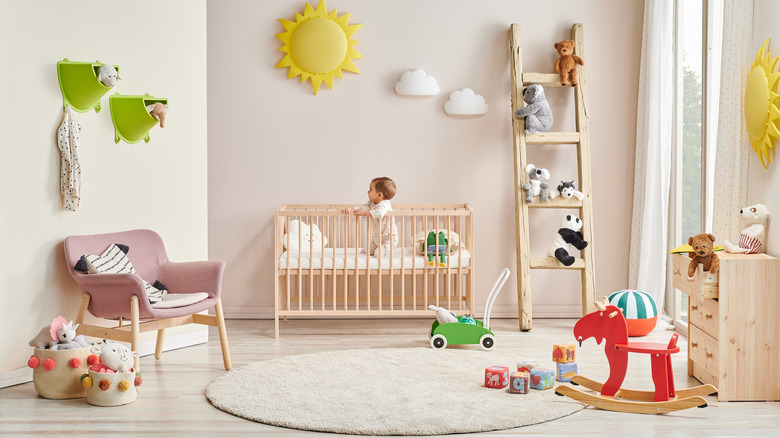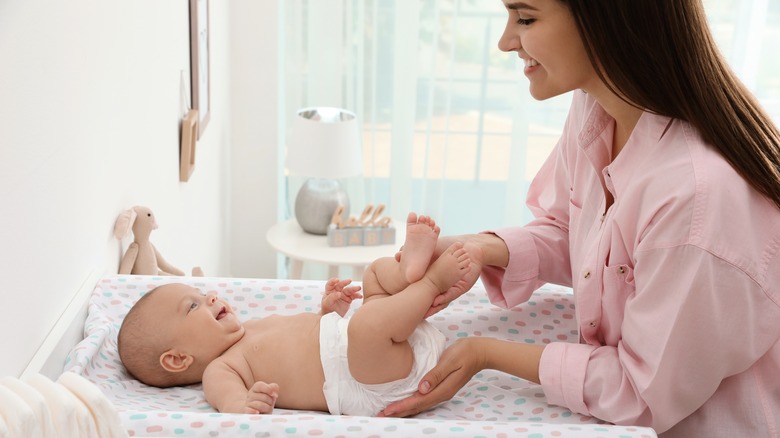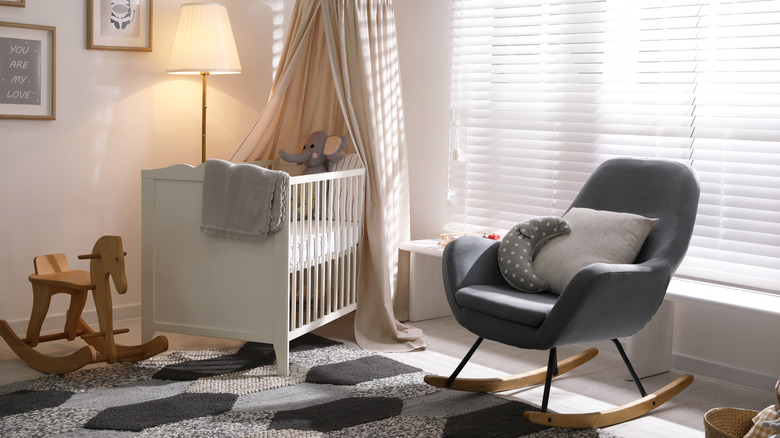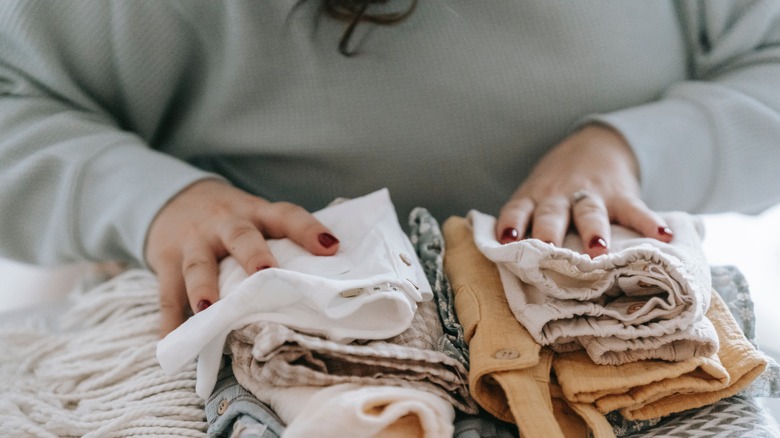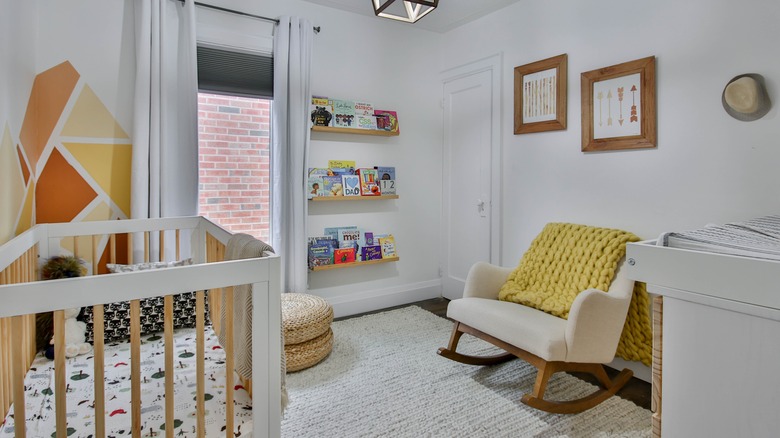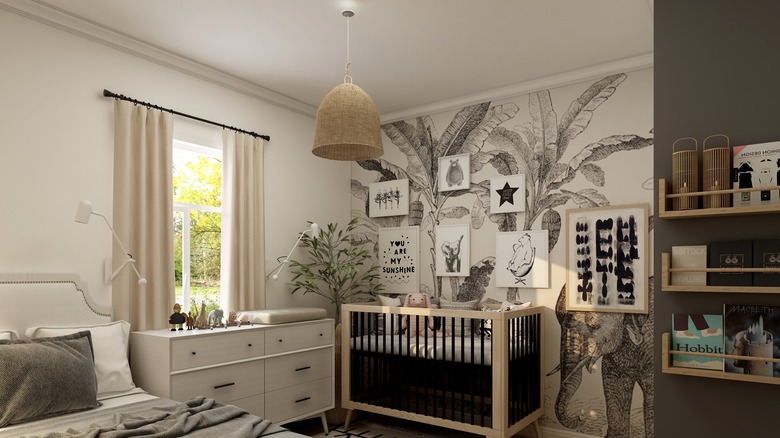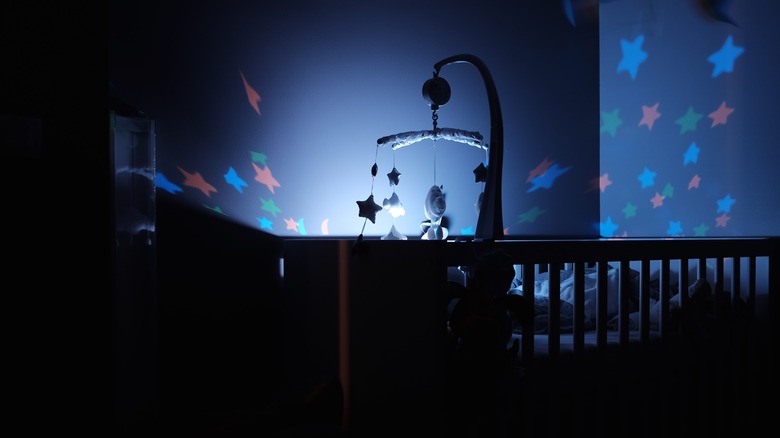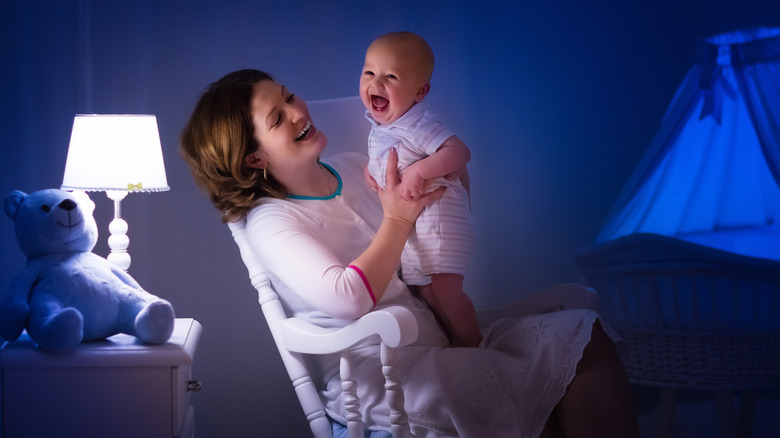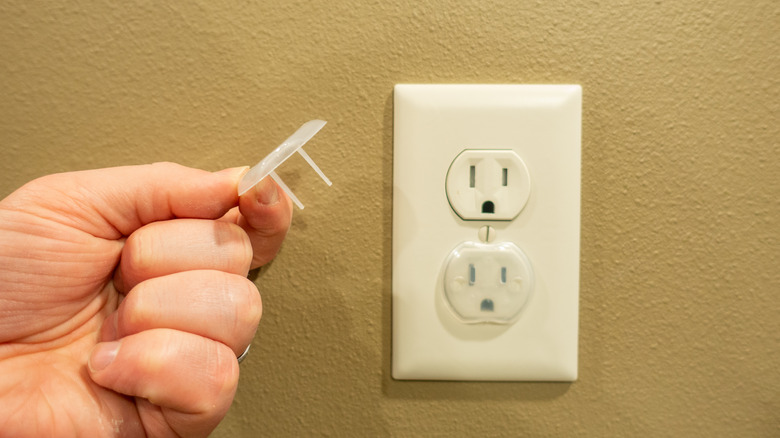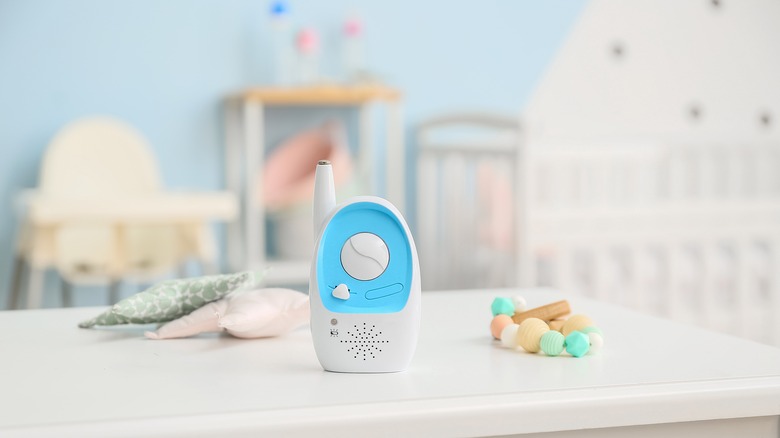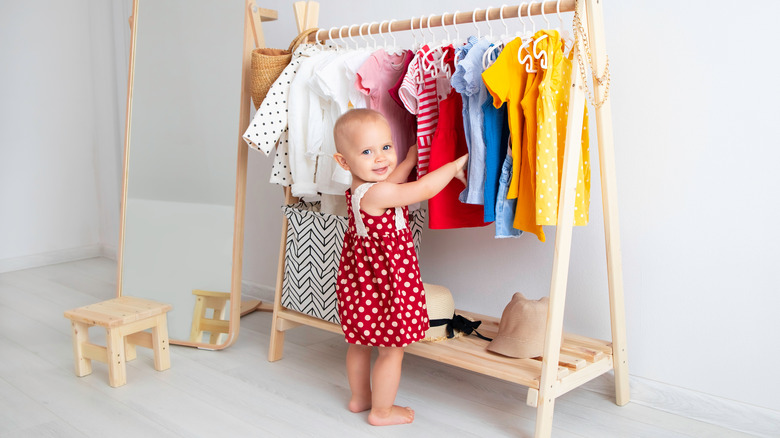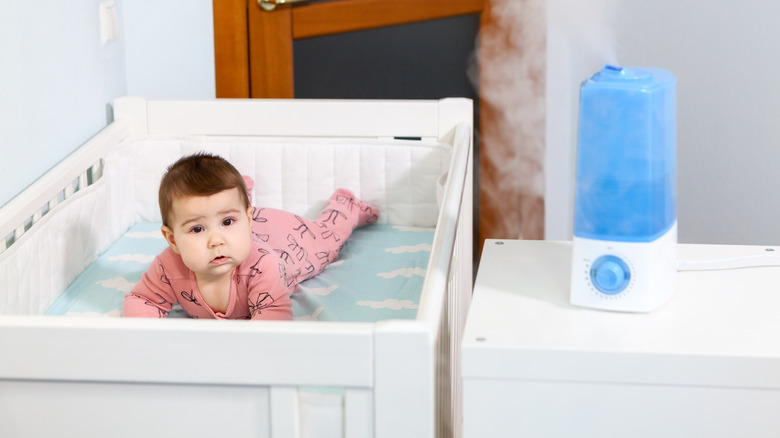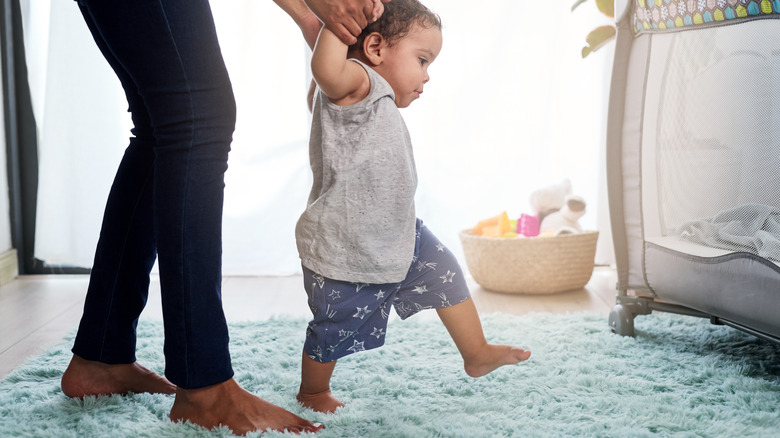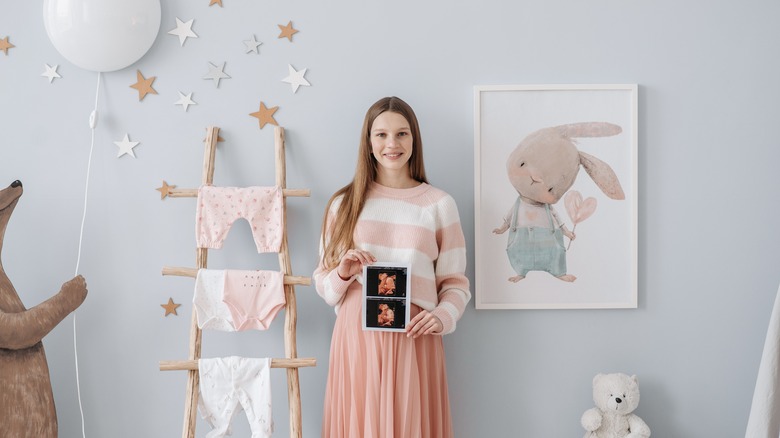Mistakes Everyone Makes When Decorating A Nursery
Designing a nursery for a newborn is important, especially for first-time parents. Much thought goes into layout plans, finding the proper furniture, and ensuring the baby is safe in its surroundings. While nursery designs can be whatever the parents desire, it's essential to keep safety in mind, stay within budget, and not go overboard with accessories that look too adult, as reported by Today Parenting Team.
When designing a nursery, think of comfort as well as functionality. Some chic nursery ideas include adding art to produce a creative environment and incorporating personal touches from the baby's loved ones. There are dos and don'ts to decorating a nursery, such as thinking of flooring, buying furniture the child can potentially grow into, and not feeling obligated to fill every inch of space. Choosing the right furniture and color for your baby's nursery can also help create a welcoming and inviting environment. Avoid these common mistakes when decorating a nursery.
Not setting up a diaper changing station
Babies go through diapers like crazy. According to La Petite Crème, the average baby can soil over 2,500 diapers within their first year. For parents with a larger home, it may be helpful to set up mini diaper changing stations in various rooms rather than just having a single changing station in the nursery. A changing table isn't always necessary, but many parents prefer to have them to prevent back pains and strains while changing their child's diaper. Changing pads placed on the floor could work just as well. Don't want to purchase an expensive changing table? Try to convert a dresser or shelf into a changing table with adjustments made for proper safety. Don't assume the baby will remain the same size within a year. Keep diapers of all sizes in a drawer for easy pickings to save time removing the plastic the diapers came in.
As well as diapers, keep baby clothes nearby in a basket next to the diaper changing station (via Living Textiles). Keep a couple of stuffed animals or rattles on hand to soothe a fussy or cranky baby. Have a laundry bin and diaper pail to dispose of dirty clothes and diapers. Keep hand sanitizer nearby to use after changing diapers.
Buying furniture for the baby to grow into
While it may seem like a promising idea to buy furniture that a baby can grow into as they grow older, keep in mind that furniture can get damaged early on, as reported by Newton Baby. Once babies reach the exploratory toddler phase, they enjoy jumping on furniture and drawing on tabletop surfaces. Invest in reasonably priced quality furniture made from sturdy materials that you can clean with at-home products.
Since sleep and bedtime are essential for a newborn, parents should focus on buying the right crib. Purchase a crib that is brand new. While hand-me-down cribs may seem like a suitable money-saving option, older cribs tend to have wiggly bolts and screws, posing a safety risk. Don't overload the crib with toys and stuffed animals. Too many objects inside a crib may cause suffocation. Buy a firm and comfortable mattress that fits correctly in a crib. Get a changing table or dresser and convert it into a changing table for diaper duties. A rocking chair will help soothe the baby to sleep. Adding a footstool helps your feet rest.
Having too much clutter
While it may be tempting to buy lots of products for the new nursery, it's best to make a wish list of wants and needs to prevent impulse buying. According to Imperfectly Perfect Mama, when deciding on a particular item, question whether it'll last for a while and if it's developmentally right for the baby. There's nothing wrong with buying items secondhand such as clothes and toys, but be sure they're in good condition before buying. It's best to declutter a baby's nursery every three months to remove broken toys, clothes that don't fit, or furniture that's no longer needed.
For the time being, there are ways to declutter and organize a baby's nursery without feeling overwhelmed (via Life Storage Blog). When storing a baby's clothing for short-term purposes, wash and neatly fold the clothes and place them in cardboard boxes. These could later be driven to a donation center or given to a family friend with babies. As for long-term clothing storing purposes, purchase plastic storage bins and use them to keep the clothes intact. This idea can be for clothing that is out of season but still fits or for a future child.
Being too gendered
There's excitement to be had when finding out your baby's gender, but some parents would rather wait until the baby is born. While many parents prefer decorating based on their hunches, designing a too stereotypically male or female nursery may not be plausible. Why not decorate the perfect gender neutral nursery by painting the walls white or ivory and incorporating adorable peel-and-stick wallpaper? According to Real Homes, peel-and-stick wallpaper is noncommittal, and there are delightful motifs to choose from, such as zoo animals and planetary space objects. Instead of fixating on whether to add pops of blue or pink in the nursery, try to brighten up furniture and design pieces with shades of red, orange, and yellow.
To keep things simple, create a minimalist nursery by placing oversized plants with natural wood furniture such as cribs and dressers (via The Spruce). Bring the outdoors inside by decorating the nursery walls with forest-inspired wallpaper. Enjoy warm weather and summer vacations? Be on the lookout for beach-inspired wallpaper to purchase online and from home design stores. Add bold colors by painting one wall evergreen or get inspired by blue nursery ideas.
Not having a theme
It would be a shame to skip the theme for your child's nursery. The Spruce suggests not going overboard and staying true to a specific design. Find furniture in neutral colors, but add accent pieces such as lamps or crib sheets to incorporate the theme. Before getting started, ensure there's space for the baby to sleep, play, and get changed. Since babies sleep quite a bit and often stay on their backs or remain in their cribs, why not paint the ceiling with a bold color or add patterned wallpaper? Doing this is one way to add whimsy to an otherwise neutral room.
Life is beautiful under the sea, so why not incorporate an aquatic theme into the nursery? Go to a home decor store or check online for framed pictures of mermaids to hang on the walls (via Nursery Design Studio). For an underwater theme, try to search for photos of narwals and play with shades of seafoam green and oceanic blue when decorating the nursery. You can also go the hot air balloon route and find a mobile to hang over the baby's crib. Use wallpaper featuring hot air balloons, and paste it on nursery room walls. Like animals? There are plenty of ways to create a safari jungle theme with stuffed jungle animals and wooden furniture.
Picking a crib that doesn't meet safety violations
New parents need to find a safe crib that meets current safety regulations. According to HealthyChildren.Org, purchasing a new crib is the way to go because antique cribs aren't up to safety regulations. With antique cribs, their slats are too far apart. Bars on cribs shouldn't be more than 2 3⁄8 inches apart to prevent the baby from getting their limbs caught and injuring themselves. Avoid drop rails because they can cause severe injuries. The crib should be away from windows and radiators to prevent the baby from overheating. As extra precautions, the baby's crib should be away from curtains or blinds with hanging strings. If strings from blinds aren't wrapped up and kept away, they could pose a choking hazard.
Find a crib that fits the baby's needs and works for long-term use (via Crate & Barrel). While parents want a regular crib, for the time being, other parents may prefer a convertible crib that transitions into a toddler bed. A bassinet may be suitable for short-term use if you live in an apartment and don't have much space. Bassinets are smaller and fit until the child is about six months old.
Not having a dark enough room
What if there was an easy solution to have a baby sleep through the night with hardly ever waking up? New and seasoned parents understand how hard it is to get their babies to sleep through the night. What if there was an easy solution? A baby's room needs to be dark to promote healthy sleeping patterns. According to DADometer, blackout curtains or blinds help a baby fall asleep. For those who want a different option and don't want to commit to blackout curtains, look for darkening blinds where natural light could still permeate through windows. You can sew blackout curtains into existing curtains or install them in a DIY project.
Blackout honeycomb curtains work well in producing darkness. As well as being dark, honeycomb curtains have insulation. They create coolness during the summer but spread heat during the winter. Parents can sometimes use night lights in their baby's nurseries to lull them to sleep. Find low-wattage bulbs and place them behind furniture so as not to disrupt the baby's sleep.
Choosing the wrong lamp or lights
Having sufficient light in a nursery is essential. The Spruce says to avoid purchasing halogen or overly bright lights because babies may feel overstimulated. To control nursery lighting without being disruptive, invest in a light dimmer. Lighted ceiling fans are another way to have light in a nursery. Ceiling fans produce coolness, and the fan motion entices babies to fall asleep. Instead of buying a plain-colored fan, find one with colorful blades or creative designs. To create a pretty aesthetic, string fairy lights around the nursery dresser or window to add light without being outlandish.
Once babies grow into toddlers, they may fear the dark and feel more comfortable with a night light (via My Practical Baby Shower Guide). Night lights are inexpensive and easy to plug into electrical outlets. Lamps with small bases can fit on top of a dresser. Compared to tabletop lamps, floor lamps aren't the best in a nursery because they could fall over and cause fires. Don't like the idea of the baby being in the dark? Find window blinds that don't completely block out sunlight to allow the sun to filter in during the daytime.
Not babyproofing the nursery
While it may seem too far into the future, babyproofing a nursery should be a top priority. When designing a nursery, keep the crib away from the window to prevent the baby from climbing up and trying to open the window. The baby could get seriously injured, as reported by Romper. Anchor heavy furniture like bookshelves, dressers, and changing tables to stop them from accidentally falling over. Baby powders and diaper creams should be kept in a different room and away from babies.
There shouldn't be sharp corners on the nursery room furniture (via Mom Loves Best). If there are, buy corner protectors and edge guards to prevent the baby from getting hurt. Make sure the furniture in the nursery is stable and doesn't have any loose table or chair legs. Electrical outlets should have outlet covers to prevent the baby from sticking their fingers in the sockets. Child-proof doorknob covers are items to consider buying to ensure the baby doesn't get out of the nursery and harm themselves.
Pros and cons of baby monitors
While parents like to be connected to their children all day, how could that work with babies? Baby monitors are good for listening in on the baby to see if they're crying and need to be changed or fed. However, baby monitors can pose an annoyance, as reported by PopSugar. Parents who live in a big home may need to have baby monitors around the house because they can't be all places at once. Smaller apartments suffer the consequence of hearing tiny noises. Baby monitors pick up on every sneeze, gurgle, and coo. Baby monitors may also be a pain to fix because every model is different. They can cause a lack of privacy due to hearing and seeing everything from other rooms in the home.
Baby monitors may be an added expense, but they are great at keeping an eye on the baby (via My Baby Nursery). A baby monitor prevents parents from walking back and forth from various rooms to consistently check on their baby. Baby monitors with video aid parents in determining whether they need to go into their baby's room or not.
Not putting away out-of-season clothing
Out-of-season clothing could get in the way of essential items in the nursery and cause disorganization. To alleviate clutter and confusion, buy some baskets at a local home for small clothing items such as socks and mittens, as suggested by Mom Loves Best. Dressers with mini chalkboard labels are great for organizing clothing. Keep out-of-season or outgrown clothes in freezer bags to save space. You can find these at dollar stores or supermarkets.
For long-term storage, keep clothing in the driest environment possible to prevent mold from growing (via The Guardian). Baby clothes can be organized and stored by age in months. Separate by zero to three, three to six, six to nine, and nine-plus to keep things in order. Some parents prefer storing clothes in the attic or the garage. If your home lacks sufficient space, place old baby clothes into a storage unit.
Not having a humidifier
For little ones who enjoy playing on the floor, a nursery rug gives them somewhere soft to sit down and focus on their toys. According to The Spruce, large rugs can cover hardwood floors, while small rugs can highlight a portion of the nursery. When deciding what kind of rug to buy, see what styles or colors the nursery lacks. Would a colorful rug liven up a neutral space? Will a plain-colored rug help calm down the overabundance of patterns? When it comes to rug materials, wool rugs are easy to clean. Cotton rugs are a popular choice made from natural organic materials.
To find the perfect rug, don't stick to rectangular shapes (via Nick + Alicia). Rugs come in all shapes and sizes. Find rugs that match the theme of the room. If the nursery features animal motifs, buy rugs that look like farm or zoo animals. For a planet-themed nursery, why not buy a star-shaped rug? To prevent rugs from slipping or sliding around, put anti-slip pads underneath them.
Buying the wrong size rug
For little ones who enjoy playing on the floor, a rug could be used in a nursery so they could have something soft to sit down on and focus on their toys. According to The Spruce, big rugs could be used to cover hardwood floors while small rugs could be used as an accent to highlight a portion of the nursery. When deciding on what kind of rug to buy, see what styles or colors the nursery is lacking. Is everything neutral and a colorful rug would add flavor? Does the nursery have too many patterns that having a plain colored rug may calm down the overabundance of design? When it comes to rug materials, wool rugs are easy to clean. Cotton rugs are common and made from natural organic materials.
When it comes to finding the perfect rug, don't limit just to rectangular shapes (via Nick+Alicia). Rugs come in all shapes and sizes. Find rugs that are designed to match the theme of the room. If the nursery is designed with animal motifs, buy rugs that look like farm animals or zoo animals. For a planetary themed nursery, why not buy a star shaped rug? To prevent the rugs from slipping or sliding around, be sure to put anti-slip pads underneath them.
Not receiving professional help
Designing a nursery is exciting and fulfilling, but sometimes it could be daunting when trying to figure out where to start first. A professional designer can help collaborate with the parents and their ideas, reports The Baby Cot Shop. An interior designer can help bring plans to fruition for those struggling with creating an aesthetic. To give your ideas to a designer, compile a paper portfolio with magazine clippings or create an online digital portfolio. Read nursery room design blogs and check out home design websites. Think outside the box by seeking out unusual designs. Why not design a nursery room with cute, red ladybugs? How about an amusement park theme with rollercoaster wallpaper?
While there are parents who want to be safe and stay with pink or blue as the primary colors, look for earth tone shades in moss green, dandelion yellow, and dark brown for a creative twist. Don't skimp out on stable and sturdy furniture. Be sure to keep baby toys and books in the nursery room. These may sound like minor objects, but they help ensure the child has a warm, safe, and enriching learning environment during their first few years of life.
